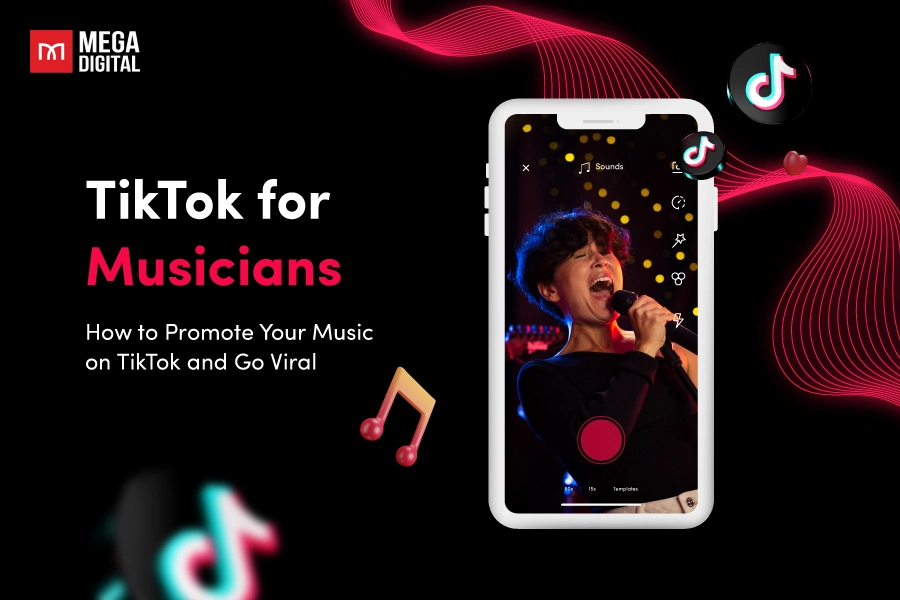Struggling to figure out who to target with your Facebook ads? You’re not alone. For new advertisers, choosing the right interests can be confusing. This guide will help you understand how to set up Facebook Ad Targeting interests and select the right targets that match your product and goals!
What is Facebook ad targeting interests?

Facebook Ad targeting interests is a feature that allows advertisers to reach people through the interests that they have shown on Facebook. These interests are then derived from the users’ activities, such as the pages they like, the content they interact with, and the pages they usually visit.
For instance, if you have an online shop that sells eco-friendly goods, you could target audiences with interests like “sustainable living”, “zero waste”, or “online shopping”.
In general, Facebook ad interest feature is the most ideal for:
- Those who are new to advertising can gradually build up their audience persona that best fits their preferred customers.
- Those who aim for niche markets can add more layers to their existing customer list and expand to broader audience segments.
How does Interest Targeting work on Facebook ads?
Like every advertising platform, Facebook ad targeting interests allows advertisers to select specific interests, behaviors, demographics, or categories that define the audience they want to reach. Let’s get down to the basics of this feature:
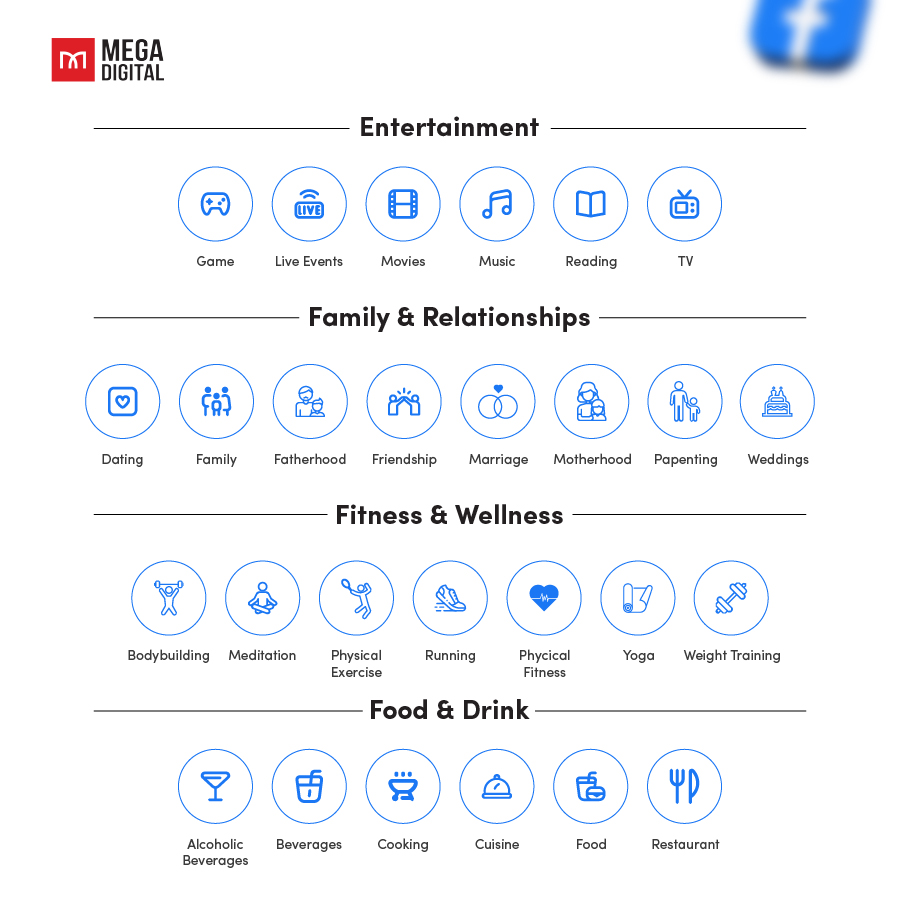
When setting up a campaign, you can select specific interests that align with your product or service. Here are some sample interests you can target:
- Hobbies
- Activities
- Entertainment
- Business & industry
- Food & drinks
- Sports & outdoor activities
- Shopping & Fashion
- Family & relationships
- Technology
Once interests are selected, Facebook utilizes its data to segment users who have indicated affinity or engagement with those chosen interests.
This targeting option can be further refined by combining it with other targeting parameters, such as demographics (age, gender, location), behaviors (purchase history, device usage), or custom audience lists.
Benefits of using Interest Targeting for Facebook Ad Campaigns
With the function of targeting audiences based on their preferences, Facebook ad targeting interests can give ad campaigns several benefits, such as:
1. Precise Audience Targeting
Interest targeting allows advertisers to reach a specific audience interested in particular topics, behaviors, or demographics. This precision helps show ads to users more likely to engage or convert, leading to higher engagement rates and improved ad performance.
2. Improved Ad Relevance Score
Facebook ad targeting interests can lead to higher ad relevance scores, which can result in lower costs and better ad placement within the Facebook platform. Advertisers can analyze campaign performance metrics, build a more detailed customer persona, and optimize their targeting strategy to improve ad efficiency and outcomes.
3. Enhanced Ad Personalization and Expand Reach
Tailoring ads to specific interests enables advertisers to create personalized content that resonates with the audience’s preferences, increasing the chances of capturing their attention.
Moreover, it allows advertisers to reach new potential customers who share interests similar to their existing audience or customer base, broadening the reach of their campaigns.
4. Better ROI and Cost-efficiency
Targeting audiences with specific interests can lead to a better return on investment (ROI) as ads reach users more inclined to show interest in the advertised products or services. As a result, advertisers can reduce wasted ad spend by focusing on users more likely to engage, click, or convert, thus improving cost efficiency.
How to set up Facebook Ad Interest?
There are 6 simple steps to set up interest-targeting options for your ad campaigns.
- Step 1: Log in to your Facebook Ads Manager account.
- Step 2: Click on “Create” to set up a new campaign or select an existing campaign. Within your campaign, select or create an ad set where you want to set up interest targeting.
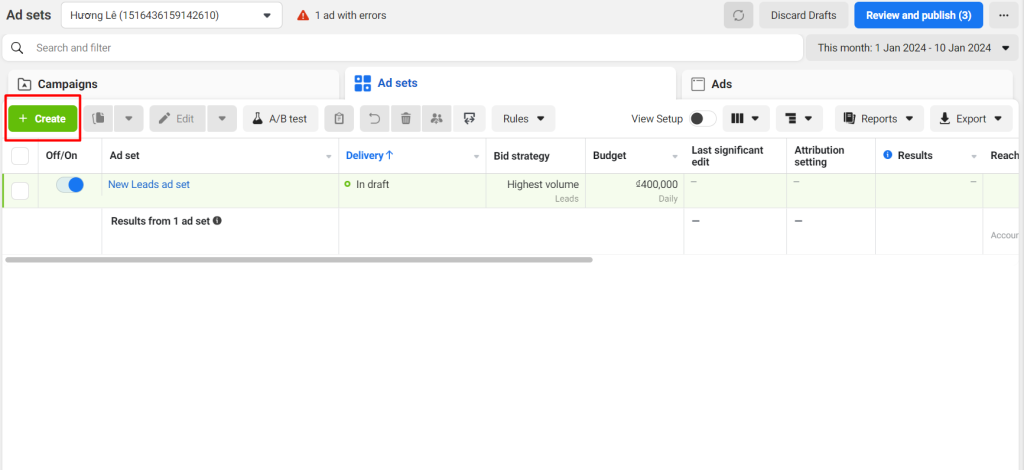
- Step 3: Scroll down to the “Audience” section in the ad set settings. Under “Detailed Targeting,” click on “Browse” or start typing to search for interests relevant to your audience.
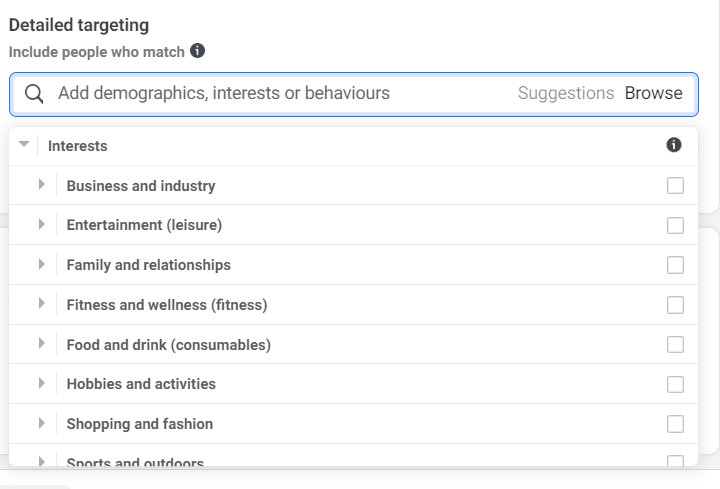
- Step 4: Facebook provides a wide range of interests. You can explore various categories, such as demographics, hobbies, behaviors, or specific topics. Choose the interests that align with your target audience.
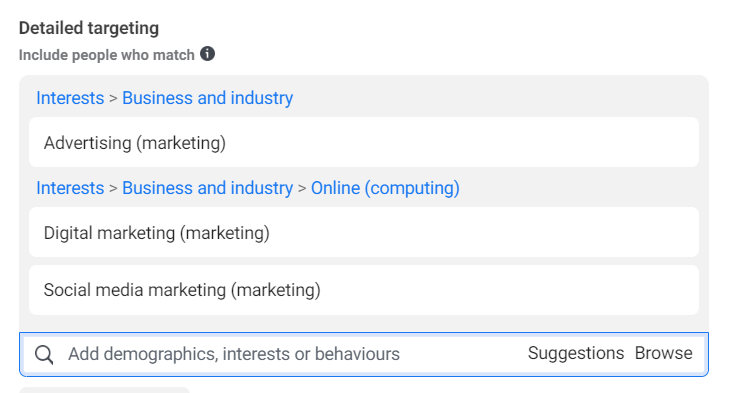
You can refine your audience by adding additional targeting parameters like demographics, location, and behaviors or excluding certain demographics.
- Step 5: As you select interests, observe the audience size gauge on the right side to ensure the audience is neither too narrow nor too broad. Aim for a balance between relevance and reach.
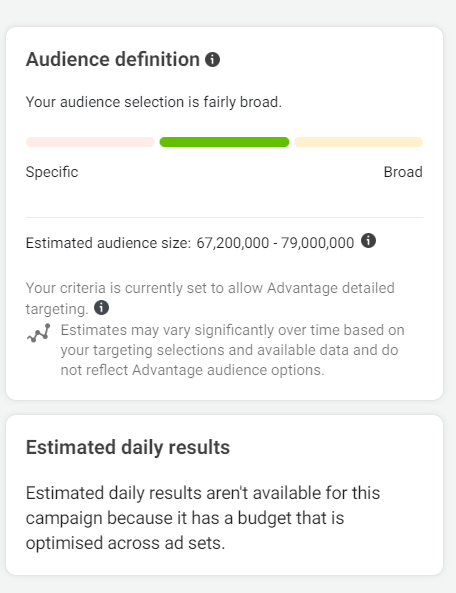
- Step 6: Once you’ve set your interest targeting and refined your audience, click “Save” or “Next” to create your ad.
Even after the ad is live, you can adjust your interest targeting strategy based on the ad’s performance metrics to optimize the campaign for better results.
Remember to experiment with various interests and combinations to identify the ones that resonate best with your target audience and drive the desired results for your Facebook ad campaigns.
How to choose the right interests for your Facebook ads?
Choosing the right interests is one of the most important steps in setting up a successful Facebook ad campaign. Here are key steps to help you find and select interests that actually match your audience and drive results.
1. Understand your product and audiences
What problem does your product solve, and who needs that solution? The answer will help you identify why they might respond to your ad in the first place.
For example, if you’re selling sportswear, your product appeals to people who usually play or watch sports. They might be fans of several athletes or clubs. Thus, instead of targeting only broad interests like “sports”, you should select interests like “major soccer league”.
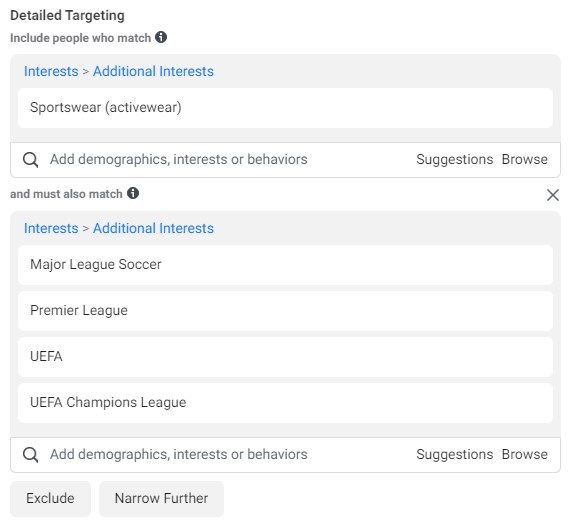
2. Brainstorm related topics and brands
Besides your product, think about what else might interest your target audience, such as competitor brands, lifestyle choices, or tools they already use. This helps uncover targeting options that feel more natural to your audience.
For instance, if you’re selling desk organizers, your customers might also be interested in minimalism, Notion app, or home office setup. These are not directly about your product, but they signal the mindset and environment of someone who might buy from you.
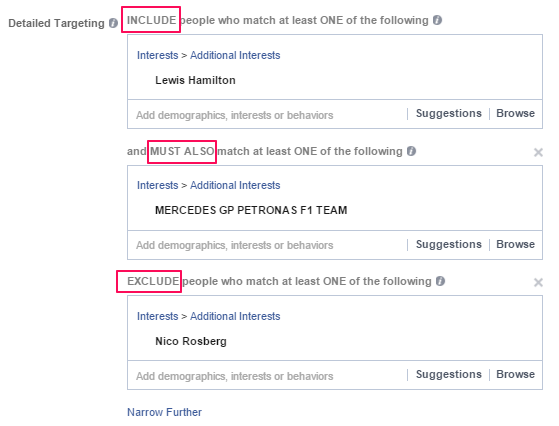
3. Start with 3-5 interests for testing
When launching a campaign, don’t overload your ad sets with too many interests. Starting with 3-5 closely related options per ad set gives you cleaner performance data and makes it easier to optimize.
Let’s say you run a pet accessory store. you could test interests like “Dog lovers,” “Pet grooming,” and “PetSmart”. After a few days of running the ad, review performance and adjust based on which interests drive better results.
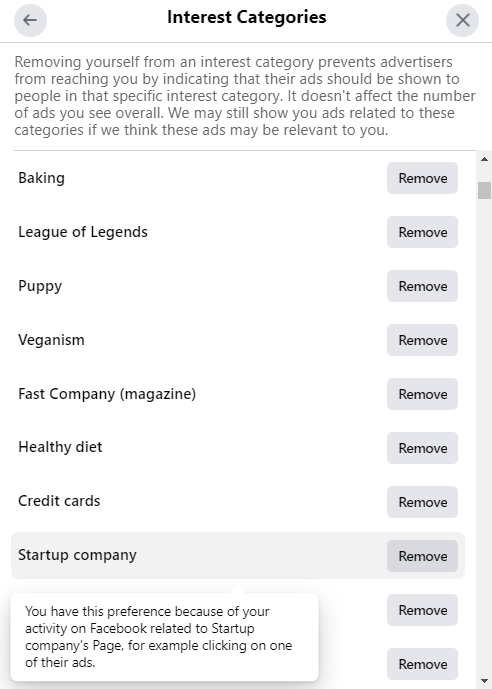
4. Mix broad and specific interests
Combining broad and specific interests in the same ad set helps Facebook balance reach and relevance. Broad interests give the algorithm more room to explore, while specific ones guide it toward the right type of user.
For instance, if you’re advertising wireless earbuds, you could pair a broad interest like “Consumer electronics” with a specific one like “Music streaming services”.
Common Errors in Setting Up Facebook Ad Interests
Several errors or issues can occur when setting up Facebook ad interests, leading to potential challenges in targeting the desired audience. Some common errors include:
1. Limited Targeting Options
Certain interests or targeting options might sometimes be unavailable due to restrictions or changes in Facebook’s ad policies. This limitation can restrict your ability to reach specific audience segments.
What to do:
Before setting up ads, remember to check for Facebook Advertising policies and jot down the restrictions concerning your creatives or targeting. If certain interests or targeting options are unavailable or restricted, try identifying alternative interests or related categories that align with your audience. Explore broader or similar interests that may serve as viable alternatives.
2. Audience Size Too Narrow or Broad
Choosing either too specific or too broad interests can affect your audience size. A narrow audience might limit your ad’s reach, while an overly broad audience might result in less relevant targeting.
What to do:
First, combine no more than 3 related interests and allow Facebook’s algorithms to work their magic with this focused interest blend. After that, monitor and optimize your detail targeting, you can add or remove if the received audiences don’t align with your target customers.
Remember to check for Facebook’s estimated audience size when setting up ad campaigns!

3. Interests Not Reflecting Audience Preferences
Sometimes, selected interests might not accurately represent your audience’s preferences. This mismatch can lead to low engagement rates or ineffective ad performance.
What to do:
Create multiple ad sets with varying interest combinations to gauge audience sizes and performance. Analyze the results to identify the ideal balance between reach and specificity for your campaign objectives.
4. Interests Overlapping or Conflicting
If multiple interests chosen for targeting overlap or conflict, it can lead to audience duplication or confusion, affecting the ad’s effectiveness.
What to do:
Assess the relevance and uniqueness of each interest. Advertisers can let Facebook suggest your next interests based on the first ones to minimize the conflicting issues.
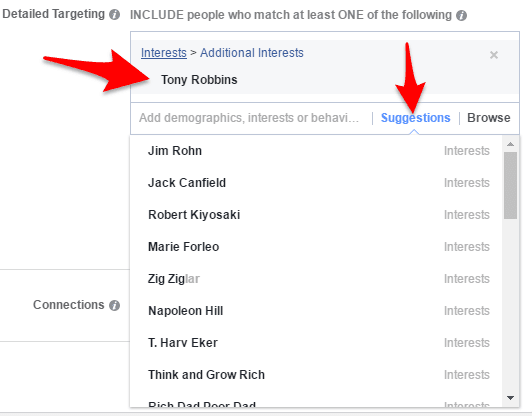
5. Exclusion of Potential Audience
Incorrectly excluding certain interests or demographics may unintentionally exclude potential customers interested in your ad.
What to do:
A/B testing multiple combinations of targeting options to see which campaigns yield the best results aligning with your objectives.
6. Limited Audience Insights
Facebook might not always provide detailed insights into why certain interests perform better or worse, limiting your ability to fine-tune your targeting.
What to do:
Continuously monitor your ad performance metrics to evaluate the effectiveness of your interest targeting. Make adjustments based on the performance data, like engagement, impression, or conversion rate, to eliminate conflicts and improve targeting precision.
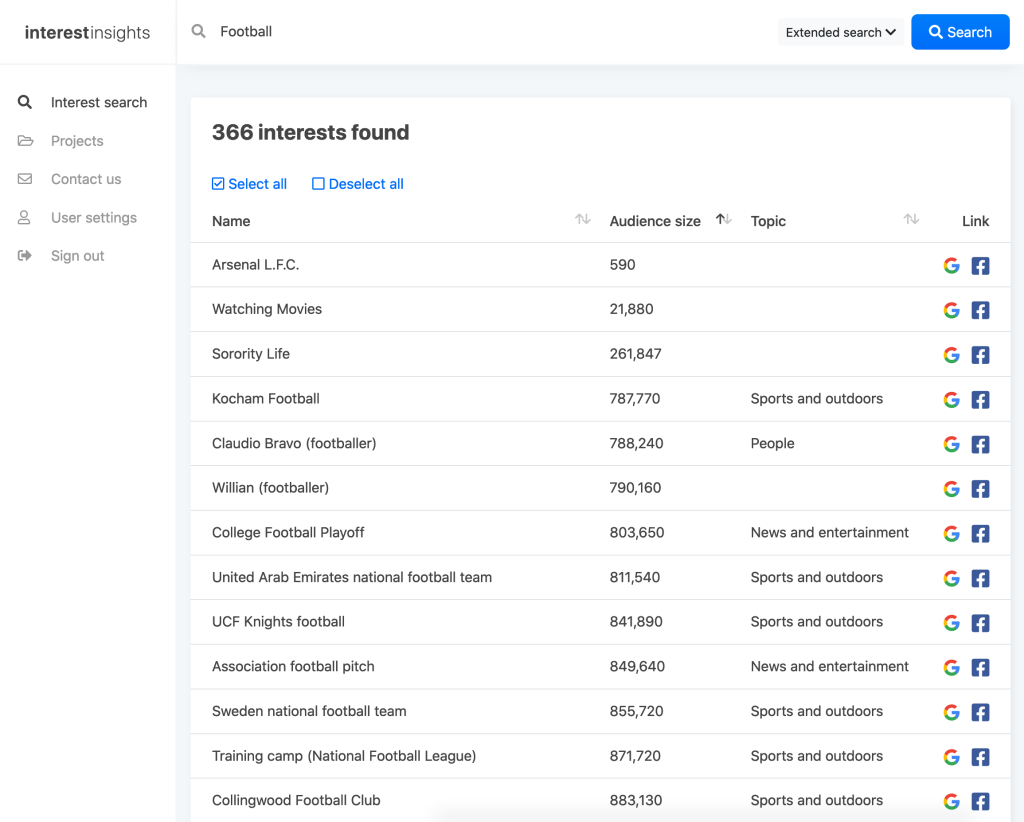
Wrap-up
Utilizing the nuances of Facebook ad targeting interests, alongside continuous testing and optimization, empowers advertisers to connect with their audiences more personalized and meaningfully. With a large user base, Facebook can offer advertisers unparalleled reach and targeting capabilities. So, don’t hesitate to expand your reach on this platform and receive outstanding results now!








